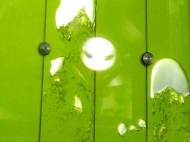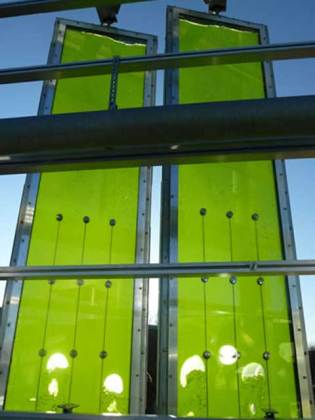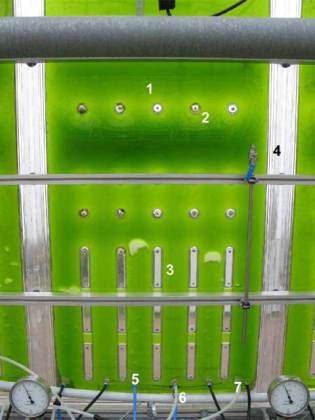Bioreactive façade with algae filled panels
 The SSC GmbH conducts extensive research since the beginning of 2008 to the development of processes and systems through to large-scale cultivation of microalgae. The technology was tested at a pilot plant in Hamburg Reitbrook back in 2008in collaboration with various colleges and universities in North Germany as part of the interdisciplinary R&D project TERM so that the microalgae technology can be used in the façade.
The SSC GmbH conducts extensive research since the beginning of 2008 to the development of processes and systems through to large-scale cultivation of microalgae. The technology was tested at a pilot plant in Hamburg Reitbrook back in 2008in collaboration with various colleges and universities in North Germany as part of the interdisciplinary R&D project TERM so that the microalgae technology can be used in the façade.
The findings helped the researchers to discover optimal ways to maximize cultivation of microalgae in Northern Europe climate throughout the year. Optimization in reactor technology led to higher cell densities in the system – thus ensuring higher production rates of 10 to 100 grams of dry weight per square meter of bioreactor surface.
The efficiency of light being used for conversion in biomass is lower compared to other available technologies, but it is sufficient for the process (five to eight percent of light is used by the algae). The research also revealed how to effectively prevent fouling of the reactor surfaces and to enable a continuous cultivation with minimal maintenance costs by an automated process and plant management.
Since November 2010, the SSC GmbH operates as part of a collaborative project to develop a microalgae technology specifically used on façades (so-called bioreactor façades). This includes a customized support system, a control system and a home energy management system.
Biofaçade being used on the BIQ House is used to cultivate microalgae in plate-shaped panels which consist of two thermoformed PET plastic cups. Bioreactor has a 2 cm (0.8 inches) wide cavity filled with a medium used to cultivate algae. The medium contains aqueous solution with nutrient salts. A constant inflow of CO2 is mixed with a supply of compressed air. Along with sunlight, this creates conditions for algae cells to multiply.
Microalgae are tiny organisms that use sunlight as an energy source to combine CO2 and nutrients (nitrogen and phosphorus) to create biomass. Although most of us are familiar with photosynthesis, many people don’t know that microalgae are far more efficient in this process because each cell of these one-celled organisms can perform photosynthesis. Microalgae can divide up to once a day, thus doubling their biomass. The biomass of microalgae is an energy carrier – 1 gram of dry biomass contains about 23 kJ of energy.
For optimal illumination, the reactors are mounted as façade. Ideally, they should be aligned to get the most of the sunshine (south and east sides of the building). The bioreactors are connected in series in order to circulate the medium throughout the system. In the plant room, the heat is dissipated through a heat exchanger and stored or used directly for heating domestic water.
Algae biomass is automatically harvested and separated in order to be fed into conversion plant which turns it into methane. The energy contained in the biomass is converted into biogas through biological conversion (the process of microbial fermentation) or the physico-chemical conversion. Both methods achieve approximately the same conversion efficiencies of about 70-80%.
Produced methane can be utilized in various ways – supplying public natural gas grid, refueling natural gas cars, used to provide heat and power for the building, or be stored for later use.
Aside controlling biomass harvesting, the automated system is used to ensure the operation with minimal maintenance. It ensures the water supply and disposal of bioreactors directly through the municipal water and sewage system. Central Energy Management system controls the vertical and horizontal alignment of the panels to ensure optimal production during the part of the day or season.
Bioreactor façades of buildings provide multiple benefits since they store CO2 in the biomass, methane is obtained from the biomass as a renewable energy source and the acquired heat can be used to heat the building. Biofaçade can also serve as shadings and protect from sunlight, weather, and serve for noise reduction.
According to the information found on SSC GmbH website, annual net energy from a 200 square-meter biofaçade is 4,540 kWh form methane and around 6,000 kWh from heat. In comparison, an average household in Germany consumes 3,100kWh per year, so the system can’t be sufficient for all the energy needs of BIQ House which has the exact biofaçade surface. The system itself actually produces 30% more energy from methane, but it is used as auxiliary power or lost during the conversion.
Despite these results, bear in mind that there’s plenty of room to improve this technology and that it can be combined with photovoltaic and geothermal technologies to aid in achieving net-zero or even better performing constructions.











Dear Madam/Sir
I have one question, what is the weigt of one panel?
Best regards
Sonja
author
Hi Sonja, there is no exact info given by them. However, after some research I could give a free estimate.
Inner capacity between glass for the algae tank is 24 liters. It is surrounded by laminated glass with 2.5 x 0.7m dimensions. So it adds around 35kg (2x 17.5kg).
If we assume they used lightweight materials to encapsulate everything, we can assume it weights between 65 and 72 kg (143-159 pounds).
HI I’ve some questions if you can anyone can help me out or lead me to it. I’d appreciate if you’ll show concern to me. Thank you !
How can we treat its smell ? Because its water where Algae grows or reproduce So there must be some smell that is’nt good